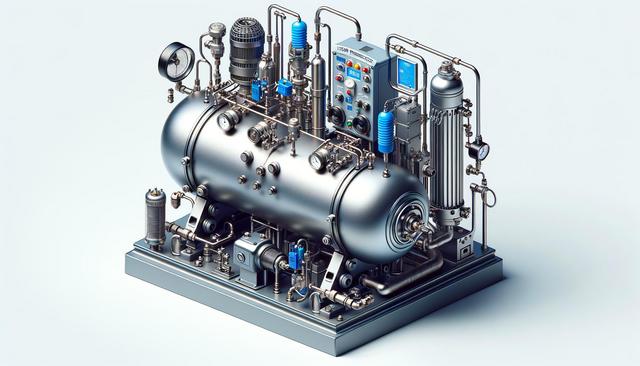Understanding High-Pressure Nitrogen Compressors
High-pressure nitrogen compressors are specialized machines designed to increase the pressure of nitrogen gas to levels required in various industrial applications. Unlike standard air compressors, these systems handle inert nitrogen gas, which is non-reactive and suitable for environments where oxygen or other gases may pose combustion or contamination risks. The core function of a nitrogen compressor is to intake nitrogen, either from a gas cylinder or a nitrogen generator, and compress it to a high pressure for downstream use.
These compressors operate using either piston, diaphragm, or screw mechanisms, depending on the application and desired flow rate. Piston compressors are common for high-pressure needs due to their ability to reach pressures well above 200 bar. The systems are often equipped with multi-stage compression chambers, intercoolers to control temperature, and filtration units to ensure gas purity. The design of the compressor must also account for the properties of nitrogen, such as its low molecular weight and its inert behavior, which may influence sealing and lubrication techniques.
How Compression Technology Works
The process of compressing nitrogen in high-pressure systems involves several stages to maintain efficiency and gas purity. Here’s a general breakdown of how these systems function:
- Intake Stage: Nitrogen gas enters the compressor from a storage tank or nitrogen generator.
- Compression Stages: The gas is compressed in one or more stages, depending on the required pressure level. Multi-stage systems offer better heat management and efficiency.
- Cooling Phase: After each compression stage, the gas passes through intercoolers to reduce temperature and prevent overheating.
- Filtration: Filters remove contaminants, ensuring the nitrogen remains pure throughout the process.
- Discharge: Finally, the high-pressure nitrogen is stored in a buffer tank or delivered directly to the application point.
Each of these stages is carefully monitored and controlled using sensors and programmable logic controllers (PLCs) to ensure safe and reliable operation. Regular maintenance and calibration are essential to sustain optimal performance and to avoid issues such as leakage or over-pressurization.
Applications in Industry
High-pressure nitrogen compressors are widely used across many industries due to the inert and stable nature of nitrogen gas. Some of the most common applications include:
- Laser Cutting: Nitrogen is used to prevent oxidation and maintain clean edges on cut materials.
- Food Packaging: The gas helps displace oxygen in packaging to extend shelf life and preserve freshness.
- Oil and Gas: Used in pressure testing pipelines and purging systems to ensure safety and efficiency.
- Electronics Manufacturing: Reduces oxidation during soldering and improves product quality.
These compressors play a critical role in maintaining process integrity and meeting stringent quality standards in these sectors. Their ability to produce high-purity nitrogen at consistent pressures makes them a key component in many production lines and quality assurance protocols.
Choosing the Right Compressor
Selecting the appropriate high-pressure nitrogen compressor depends on several factors, including the required pressure, flow rate, duty cycle, and operational environment. Key considerations include:
- Pressure Range: Determine the maximum pressure your application needs. Some systems require pressures up to 300 bar or higher.
- Flow Rate: Evaluate how much nitrogen you need per minute or hour to avoid under-sizing or over-sizing the system.
- Mobility: Consider whether a stationary or portable compressor is better suited to your workspace.
- Energy Efficiency: Look for models with energy-saving features such as variable speed drives or energy recovery systems.
- Maintenance Requirements: Choose a model with accessible parts and a reliable maintenance schedule.
Working with a reputable supplier can also help ensure you’re getting a compressor that meets all regulatory and operational standards. Custom solutions are available for industries with highly specific requirements, such as pharmaceutical or aerospace sectors.
Maintenance and Safety Considerations
Maintaining a high-pressure nitrogen compressor involves routine checks, timely part replacements, and adherence to safety protocols. Since these systems operate under high pressure, neglecting maintenance can result in equipment failure or safety hazards. Key maintenance tasks include:
- Inspecting seals and valves for leaks or wear
- Checking filters and replacing them as needed
- Monitoring oil levels and changing oil in lubricated systems
- Cleaning intercoolers and ensuring proper airflow
- Testing safety valves and pressure relief mechanisms
Safety is paramount when working with high-pressure systems. Operators should be trained to handle compressed gases, understand emergency shut-off procedures, and use personal protective equipment (PPE). Additionally, systems should be equipped with pressure gauges, alarms, and automatic shut-offs to prevent over-pressurization or overheating.
Conclusion: Meeting Industrial Demands with Reliable Compression
High-pressure nitrogen compressors are a vital part of many industrial operations, offering a reliable source of pure nitrogen for applications ranging from laser cutting to food packaging. Their ability to deliver gas at high pressures with consistent purity makes them indispensable in environments where precision and safety are non-negotiable. Selecting the right compressor and maintaining it properly ensures long-term performance, operational efficiency, and compliance with industry standards. For businesses that rely on nitrogen in their daily processes, investing in a high-quality compressor system is not just a technical necessity—it’s a strategic advantage.




Leave a Reply